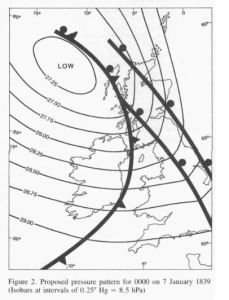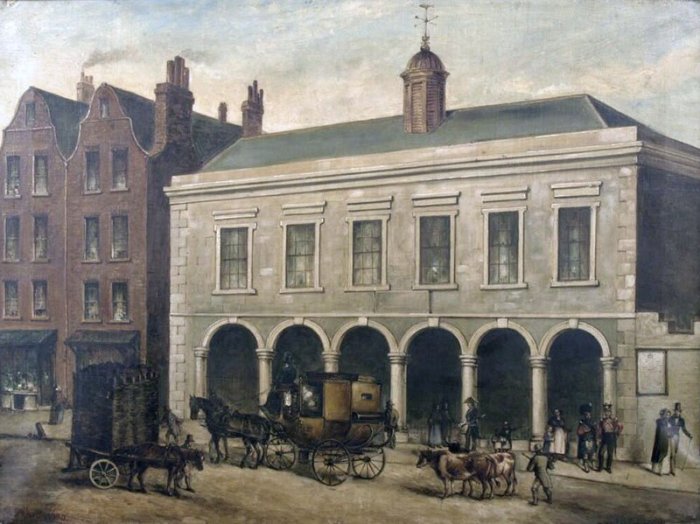
The violent hurricane that hit Ireland on the 6-7th of January 1839, became known throughout the country as the “Night of the Big Wind”. This was a classic case of understatement, as the winds on that night are estimated to have reached 100 knots (115mph). Trees were uprooted all over the country, thatched roofs blown from houses, thousands of tonnes of hay scattered, and livestock lost.
In one case, a small pig was apparently lifted from a field in Co. Down and carried a quarter of a mile before coming to rest in the branches of a tree. In Dublin, the Bethesda Chapel, capable of holding 2,000 people, was burnt to the ground as the wind fanned the flames of an earlier fire. Sparks from this fire ignited the adjoining houses and the army had to be called to contain the blaze. The back wall of the Guinness Brewery collapsed killing nine of their best dray horses. In the village of Kilkee, 32 houses were “unroofed” and in Ennis “almost every second house is damaged”. At Newgrove, Tulla, Co. Clare “3,000 trees were blown down including the largest cedar tree in Ireland” along with “thousands of dead rookery.”

Limerick did not escape its wrath. There were 16 deaths at Limerick Port as a multitude of ships were torn from their moorings including the schooner, Undine. In Castletroy, Milford House was dismantled, Plassey House damaged. 40 trees torn up at Corbally. 100 trees uprooted at Lisnagry. In Caherguillamore Demesne near Bruff, “200 crows were found dead, having perished by the severity of the night”.
The following quotes are taken from the eyewitness account ‘Awful and Destructive Tempest’ published in the Limerick Chronicle, 9th January 1839.
“..that in the memory of the oldest inhabitant living, such a storm or tempest as that of Sunday night is wholly unknown in Limerick. Sunday evening between four and five o’clock the temperature was quite mild and the atmosphere gave no evidence of the elementary conflict to follow.
One glass, a faithful index of the weather, early that evening showed the quicksilver under the extreme lowest mark of the barometer. At 8.30pm the storm set in, blowing a rough gale, which increased in fury every hour, until midnight when it raged as a perfect Hurricane.
All of the gas lamps were extinguished. The watchmen took refuge, in terror of their lives, under hall-door porticos, no living creature being able to stand the streets. Streaks of lightning, at intervals, illuminated the midnight darkness,as showers of slates at every angle, strewed the ground, in pieces.
Not a public edifice or institution in the City escaped the ravages of the storm, all suffering material damage in the fierce encounter. The best built houses of the New Town, were sadly dismantled in the upper stories…house tops and flues fell prostrate.
The crash of window glass was general and incessant. Whole stacks of chimneys would occasionally tumble down, after struggling with the blast like a drunken man to hold his equilibrium. At Arthur’s Quay, the houses rocked like a cradle, and when the affrighted families hurried from their beds to the vaults below for protection they were repulsed by the rush of water from the inflowing tide, raised to an unusual height by the force of its kindred element.
The English and Irish Towns (the abode of the less affluent), are a scene of ruin and dilapidation. A crowd of people gladly took refuge in the hall of the Exchange, whose gates were thrown open to receive them. Here they remained until daylight, many of them with only a blanket or sheet, for in their anxiety to escape they did not bring clothing.
In some cases entire slated roofs sunk, and sleeping rooms were instantly transformed into a mass of rubbish, terror seizing the occupants. Happily in those cases, no serious casualty occurred, as the impending danger induced most them to quit possession minutes before.”

There were also exaggerated reports of loss, such as the the Ship Madras, which was thought to be lost with all hands on board but in truth it was safely tuck up at Scattery. http://limerickslife.com/madras/
I think the ‘Night of the Big Wind’ and how it was used to tell if a person was of pensionable age was a very interesting part of Irish history (actually I must look up to see how true that story is)
LikeLiked by 1 person
I think it is part myth, but let me know what you find.
LikeLiked by 1 person
Got it! Page 8 and endnotes 18 & 19 at the end of the document http://researchrepository.ucd.ie/bitstream/handle/10197/504/ogradac_workpap_034.pdf?sequence=3 and it seems that this form of questioning was soon discounted when trying to establish a persons age.
So it was a question but was not proof, why let facts get in the way of a good story.
LikeLiked by 1 person
Nice work!
LikeLiked by 1 person